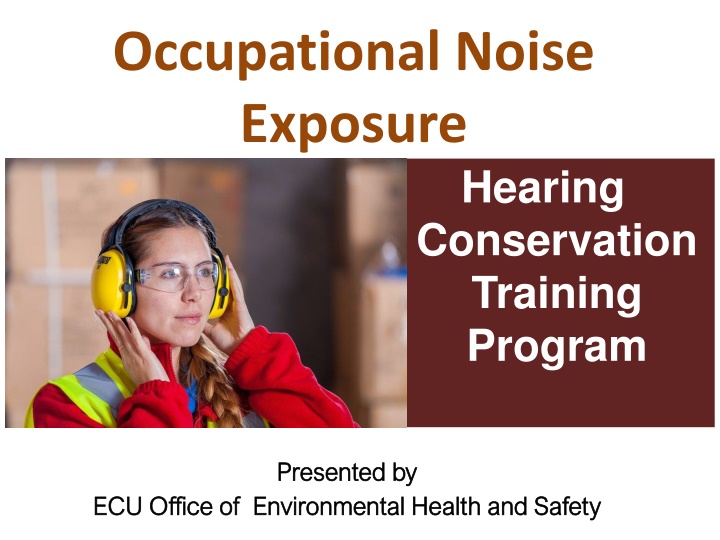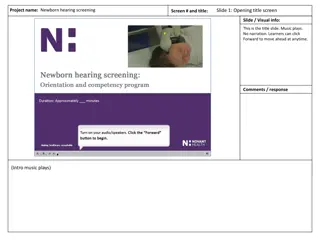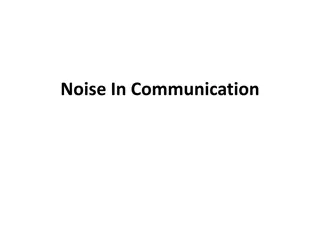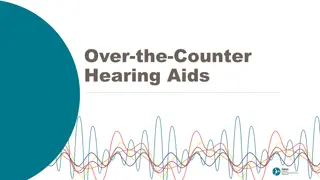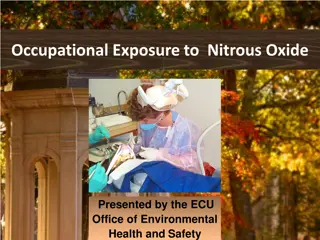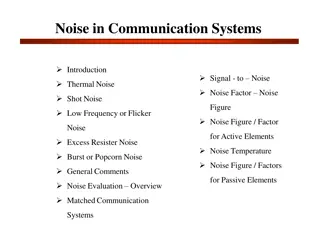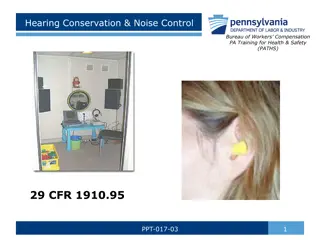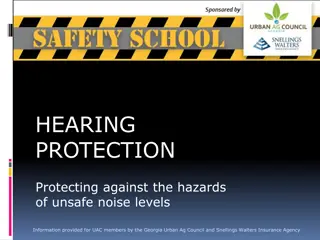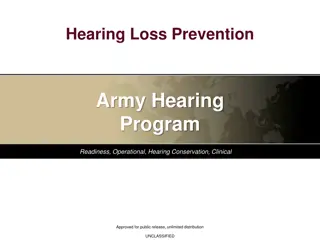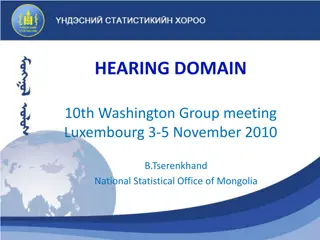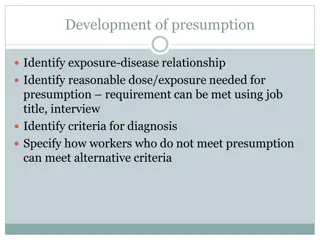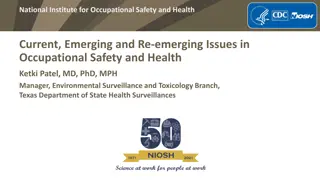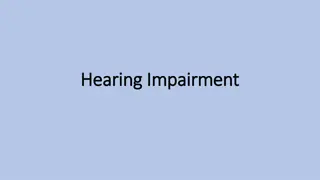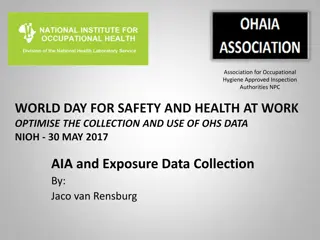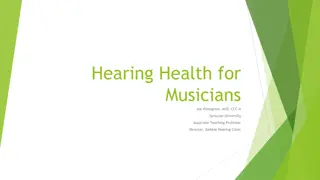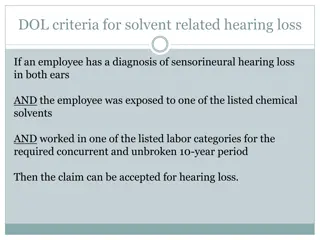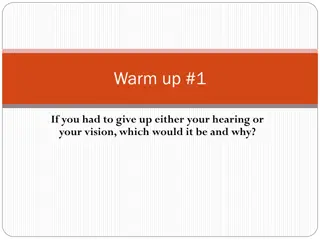Occupational Noise Exposure and Hearing Conservation Training Program
Learn about the Occupational Noise Exposure and Hearing Conservation Training Program presented by the Office of Environmental Health and Safety at ECU. This program aims to educate workers about the risks of noise-induced hearing loss, the importance of prevention, and the selection of appropriate hearing protection devices. Discover the impact of noise exposure on health, signs of hearing loss, and measures to safeguard your hearing in noisy work environments.
Download Presentation

Please find below an Image/Link to download the presentation.
The content on the website is provided AS IS for your information and personal use only. It may not be sold, licensed, or shared on other websites without obtaining consent from the author.If you encounter any issues during the download, it is possible that the publisher has removed the file from their server.
You are allowed to download the files provided on this website for personal or commercial use, subject to the condition that they are used lawfully. All files are the property of their respective owners.
The content on the website is provided AS IS for your information and personal use only. It may not be sold, licensed, or shared on other websites without obtaining consent from the author.
E N D
Presentation Transcript
Occupational Noise Exposure Hearing Conservation Training Program Presented by Presented by of Environmental Health and Environmental Health and Safety ECU ECU Office Office of Safety
Did You Know? About 30 million workers are exposed to hazardous noise on the job Noise-induced hearing loss is the most common occupational hazard for American workers Hearing loss from noise is slow and painless; you can have a disability before you notice it If you must raise your voice to speak with someone only 3 feet away, you are in high (hazardous)noise. It is 100% preventable Source Noise and Hearing Loss Prevention | NIOSH | CDC.
What is Noise? Noise is any unwanted sound By-product of many industrial processes, e.g. operating machinery Exposure to high levels of noise may lead to hearing loss and other harmful health effects
General General E Estimate stimate of Work Work- -Related Related Noises Noises of Source: NIOSH
Common Sounds may be louder than you think
Anatomy of the Ear Containing the vestibule, semicircular canals, and the cochlea. Region where damage that causes hearing loss occurs
Signs of Hearing Loss Do you ask people to speak louder so that you can hear? Do you have to turn the TV or Radio so loud that others complain?
Hearing Loss Temporary Hearing Loss -results from shortterm exposure tonoise -hearing returns whenaway from thenoise Permanent Hearing Loss - results from exposure to a moderate or high level of noise over a long period oftime -hearing loss isPERMANENT
Selection of Hearing Protection Devices Hearing protection devices are selected according to: Employeecomfort Level of noise exposure NRR of device Type of work beingperformed Environmentalconditions Employee may select hearing protection from a variety ofsuitable hearing protectors provided byemployer.
Types of Hearing Protection Devices Ear muffs Foam insert earplugs Semi-aural earplugs Earmuffs Earplugs Ear caps or bands
Ear Muffs Disadvantages Higher cost Eye glasses can interferewith ear muffseal May be uncomfortable inhot environments Must be cleaned beforeuse by anotherworker Advantages More protection at higher frequencies thanearplugs Various NRRsavailable Durable, longlasting Can be fitted on hardhat Reusable
Foam Insert Earplugs Advantages More protection atlower frequencies thanmuffs Disadvantages Hands must be cleaned before insertingearplugs Improper insertion reduces NRRvalue Various NRRsavailable Inexpensive;disposable Can be custom moldedfor individual worker Reusable plugs areavailable
Semi-aural Caps Advantages Various NRRsavailable Easy to insert May be used severaltimes Ideal for people going inand out of noisyareas Disadvantages Improper insertionreduces effectiveness More expensive thanear plugs Typically have lower NRRs than plugs ormuffs
Fit, Use and Care of Hearing Protection Devices Employer must ensure proper initial fitting Employer must supervise the correct use of hearing protectors Hearing protectors must be replaced as necessary at no cost to employee, contact your supervisor Hearing protection devices must be cleaned and stored according to the manufacturer s specification\ For questions concerning selection of hearing protection based on NRR and proper fit contact EH&S @ 328-6166
Audiometric Testing Monitors employee s hearing over time Baseline audiogram must be performed within first 6 months of work exposure ( 8 hour TWA 85 dBA) Annual audiograms are required each year after baseline audiogram Employer must pay for the cost of each required audiogram
Why Do Audiometric Testing? Obtain a Baseline Audiogram for future comparison Identify occupational hearing loss Identify Standard Threshold Shifts (STS) An STS is an average shift in either ear of 10 dB or more at 2,000, 3,000, and 4,000 hertz.
Normal Vs Noise-Induced Audiometric Testing?
Access to Information and Training Materials A copy of the OSHA 29 CFR1910.95 standard available to affected employees online @ www.osha.gov OSHA Occupational noise exposure standard must be posted in the workplace Employer is responsible for record keeping regarding employee noise exposure measurements for 2 years. However, the audiometric test records are kept for the duration of employment of the employees who are in the hearing conservation program.
To receive credit for this training please complete the linked QUIZ Questions 211 South Jarvis Street, Suite 102, Greenville NC 27858 Online: www.ecu.edu/oehs Email: safety@ecu.edu Phone: (252) 328-6166
